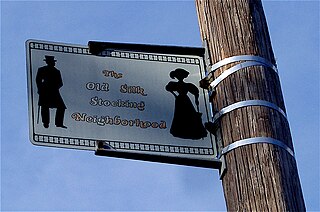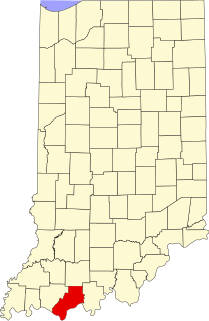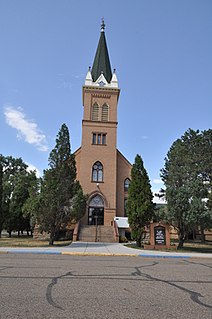
Saint Paul's Evangelical Lutheran Church is a congregation of the Lutheran Church–Missouri Synod (LCMS) located at the intersection of Barr and Madison Streets in Fort Wayne, Indiana. Founded in 1837, it is the second oldest Lutheran church in Indiana and the oldest in the northern part of the state. Thanks largely to its size and to the leadership of its pastors, it has long played a prominent role in Indiana Lutheranism and in the Missouri Synod as a whole.

The Old Silk Stocking Neighborhood is the historic district near downtown Kokomo, Indiana, and the Westside Business District. In 1886, natural gas was discovered in north central Indiana. The area exploded with people, who then developed the neighborhood. This historic area of town was the place where lawyers, doctors, industrialists and even a mayor would come to build their turn of the century residences.

Temple Israel is a historic synagogue located at Lafayette, Tippecanoe County, Indiana. Its 1867 building is one of the oldest synagogue buildings in the United States.

This is a list of the National Register of Historic Places listings in Winona County, Minnesota. It is intended to be a complete list of the properties and districts on the National Register of Historic Places in Winona County, Minnesota, United States. The locations of National Register properties and districts for which the latitude and longitude coordinates are included below, may be seen in an online map.

This is a list of the National Register of Historic Places listings in Spencer County, Indiana.

The Oxford Presbyterian Church is a historic Presbyterian church located at Oxford, Indiana, USA. Its congregation originated as an offshoot of Central Presbyterian Church of Lafayette, Indiana. At the time of its establishment, there were two separate churches, First and Second Presabyterian Churches of Lafayette. In 1914, they merged as Central Presbyterian. The church was built in 1902 and is a 1½-story, Romanesque Revival style brick building with a gable / hipped roof. It features a three-story, square corner tower with a pyramidal roof.

St. John's Episcopal Church is a historic Episcopal church located at Lafayette, Tippecanoe County, Indiana. Founded by Parson Samuel R. Johnson, early services were held beginning in 1836–37 in the counting room of Thomas Benbridge. Benbridge had an accounting office. The first building dedicated on 30 Dec 1838 on Missouri St. A new Gothic Revival style church was built in 1858 on the Northwest corner of Sixth and Ferry. Major repairs were completed in 1887 with the addition of a Sunday School.

This is a list of the National Register of Historic Places listings in Big Stone County, Minnesota. It is intended to be a complete list of the properties and districts on the National Register of Historic Places in Big Stone County, Minnesota, United States. Latitude and longitude coordinates are provided for many National Register properties and districts; these locations may be seen together in an online map.

St. Paul's United Church of Christ of Laramie was founded in 1886 as the first German language congregation in Wyoming. The church building was listed on the National Register of Historic Places in 1983. The cornerstone was laid on July 13, 1890, three days after statehood. Clergy from Chicago and the local Christian, Methodist, Episcopal, Presbyterian and Baptist Churches participated in the ceremony, with an address by Dr. John Wesley Hoyt, former Governor of Wyoming Territory and at the time first president of the University of Wyoming. The building was completed and dedicated on January 18, 1891. It is the oldest church structure in Laramie continuously used by the same congregation. With its stained glass windows and heavy wooden furnishings, St. Paul's is reminiscent of rural German churches. Those elaborate windows and its many simplified Gothic elements make the building unique among Lutheran churches in Wyoming.

The German Evangelical St. Johns Church on Church Avenue in Hebron, North Dakota, also known as the Deutsche Evangelische St. Johannes Kirche, is now known as St. John United Church of Christ. The church building was listed on the National Register of Historic Places in 2001.

Evangelische Lutherische Emanuels Kirche, also known as Emmanuel Evangelical Lutheran Church and Hill Church, is a historic Lutheran church complex and national historic district located near Dubois in Harbison Township, Dubois County, Indiana. The main church was built in 1901, and is a one-story, rectangular High Victorian Gothic style frame building. It has a front gable roof and rests on a stone foundation. It features a large steeple structure consisting of a square tower, octagonal drum, and spire. Also on the property are the contributing cemetery, schoolhouse (1889), and parsonage (1891).

Santa Claus Museum & Village is an attraction being developed near the community of Santa Claus, Indiana. In 2005, a local development company purchased Santa's Candy Castle and other buildings that comprised Santa Claus Town and announced plans to restore and re-open them to the public. Santa's Candy Castle was the first building of the original Santa Claus Town to be re-opened to the public, when its doors opened on July 1, 2006. The 40-ton, 22-foot concrete Santa Claus statue was restored in 2011. In 2012, a local historic church and the town's original post office were moved to the site next to the large Santa Claus statue.

West End Historic District, also known as the West Central Neighborhood, is a national historic district located at Fort Wayne, Indiana. The district encompasses 596 contributing buildings in a predominantly residential section of Fort Wayne. The area was developed from about 1840 to 1935, and includes notable examples of Greek Revival, Late Victorian, and Bungalow / American Craftsman style residential architecture. It is the location of numerous middle- and upper-income residential buildings, the University of Saint Francis Performing Arts Center, and Trinity English Lutheran Church—the last designed by Bertram Grosvenor Goodhue.

Southwood Park Historic District is a national historic district located at Fort Wayne, Indiana. The district encompasses 1,889 contributing buildings, 1 contributing site, 4 contributing structures, and 1 contributing object in a predominantly residential section of Fort Wayne. The area was developed between about 1906 and 1965, and includes notable examples of Colonial Revival, Tudor Revival, Mission Revival, and Bungalow / American Craftsman style residential architecture. Its development is directly related to the implementation of the 1912 plan for Parks and Boulevards for the city of Fort Wayne by city planner and landscape architect George Kessler.

Fort Wayne Park and Boulevard System Historic District is a national historic district located at Fort Wayne, Indiana. The district encompasses 34 contributing buildings, 61 contributing sites, 70 contributing structures, and 15 contributing objects in 11 public parks, four parkways, and ten boulevards associated with the parkway and boulevard system in Fort Wayne. The system was originally conceived in 1909 by Charles Mulford Robinson (1869–1917) and further developed and refined by noted landscape architect and planner George Kessler (1862-1923) in 1911–1912. The buildings reflect Classical Revival and Bungalow / American Craftsman style architecture. Later additions and modifications include those by noted landscape architect Arthur Asahel Shurcliff.

St. George Lutheran Church is a historic Lutheran church located in Jackson Township, Shelby County, Indiana.

Shelbyville Commercial Historic District is a national historic district located at Shelbyville, Shelby County, Indiana. The district encompasses 149 contributing buildings, 1 contributing site, and 2 contributing objects in the central business district of Shelbyville. It developed between about 1822 and the 1930s, and includes notable examples of Italianate, Second Empire, Beaux-Arts, Classical Revival, and Art Deco style architecture. Notable contributing resources include the Shelbyville Central Schools Administrative Offices (1912), Carnegie Library (1902), First Baptist Church (1903), St. Joseph Catholic Church and School (1908), Civic Center (1932), Melton Jewelry Store (1886), Blessing-Deprez Building (1869), Knights of Pythias (1901), Cherry Building (1889), I.O.O.F. Building (1895), Old High School Building (1886), and a statue of Charles Major (1929).

Jefferson Historic District is a national historic district located at Lafayette, Tippecanoe County, Indiana. The district encompasses 161 contributing buildings, 2 contributing sites, and 22 contributing structures in a predominantly residential section of Lafayette. It developed between about 1853 and 1951 and includes representative examples of Italianate, Greek Revival, and Bungalow / American Craftsman style architecture. Notable contributing resources include the Deutsche Evangelische Kirche (1905), Isador Metzger House, Hubert Gilmartin House, B.F. Biggs Pump Factory Building, Deutsche Methodist Kirche (1885), Herman & Mary Fletemeyer House, Mohr House, Warrenberg-Reule Double House, Alfred Gaddis House, Wabash Valley House (1862), Haywood Tag Company Building (1928), and Jefferson High School (1927).
West Lafayette Baptist Church (1898-1964), also known as Church of the Good Shepherd (1964-1976), was a historic Baptist church located at West Lafayette, Tippecanoe County, Indiana. It was built between 1898 and 1901, and was a two-story, cross shaped Gothic Revival style brick building. It featured a corner bell tower with three-tiered masonry buttresses. The Cynthia Jones Hall was added in 1936-1937 and the church was remodeled in 1951.

Watson Park Historic District, also known as Watson Road Historic District and Watson McCord Neighborhood, is a national historic district located at Indianapolis, Indiana. The district encompasses 402 contributing buildings and 4 contributing sites in a predominantly residential section of Indianapolis. They include 255 houses, 27 multiple family dwellings, and 120 garages. It was developed between about 1910 and 1960, and includes representative examples of Colonial Revival, Tudor Revival, and Bungalow / American Craftsman style architecture. Located in the district is the Watson Park Bird Sanctuary.























